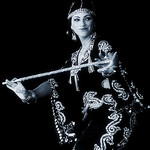Posted in Articles
The Big 5: Saidi

This post is part of my series on “The Big 5”. Those are the genres that an educated audience would recognize, and expect certain dance stylizations.
(i.e., the genres for which just listening to the music isn’t enough.)
To read more about this idea, or to find links to the other articles in the series, check out the first article in the series, The Big 5.
Saidi
What it is:
A genre of music from Upper Egypt, usually featuring the Saidi rhythm (dum-tak, dum-dum, tak).
There is a style of men’s folk dance done to this genre, which evokes fighting with a quarterstaff. The women’s style is a lighter, more feminine version. (I’m told it pokes fun at the men’s style, but I haven’t verified that.)
A Saidi number is very commonly included in an Egyptian show, where it can be done with folkloric styling or fancified for the stage.
Relevant styles:
This is a must for Egyptian style.
It’s often used in Vintage Orientale (aka AmCab), but isn’t a requirement.
It’s rarely used in Turkish style, except as a reference to Arabic styles.
Aesthetics:
Saidi is usually danced with a cane (assaya) or stick (tahtib), but may be danced straight-up with zils.
It typically includes lots of earthy hipwork, fancy cane-twirls, and framing with the cane. There are a few Saidi-specific steps, including rocking steps, hops, and “horsey” moves with the legs.
Resources:
There are instructional DVDs out there by Virginia*, Nourhan Sharif*, and Shareen el Safy.
There’s also a handy article with video clips at:
http://www.bellydancestuff.com/styles-saidi.html
Songs to know:
Sallam Allay*, Samah El Noba*. Anything that includes “assaya” or “saidi” in the title is probably a good bet.
Lebanese dancers often dance with a cane to debke music, like Al Ya Ein Mulayitein* aka Shashkin.
Tips:
The Saidi rhythm is extremely versatile, and often appears outside of the Saidi genre.
When you’re dancing to music in the Saidi genre, an educated audience will expect you to dance in Saidi style, or at least to reference it.
When the rhythm appears in a non-Saidi song, referencing that style won’t go amiss, but it isn’t required.
(i.e., if your song has a Saidi interlude, you don’t have to run off stage and grab your cane.)
Check out the next article in the series: Beladi Progression
Your Turn
Are you a fan of Saidi?
What songs do you think are must-knows?
Do you know of any other resources for learning about Saidi?
Share your thoughts in the comments.
* Note: links marked with a * are Amazon affiliate links, meaning that I will get a small commission (typically a few cents) if you make a purchase through them.
If you’d prefer that I not get that commission, just search Amazon directly for the title you’re looking for. That’s 100% okay by me.
I have NOT personally used all of the items featured on this page; they are just resources I found that might be helpful based on their descriptions and reviews.
The fabulous photo on this page is by Nico Nelson, used under a Creative Commons license. If you recognize the dancer is, let me know, so I can give her credit too.
